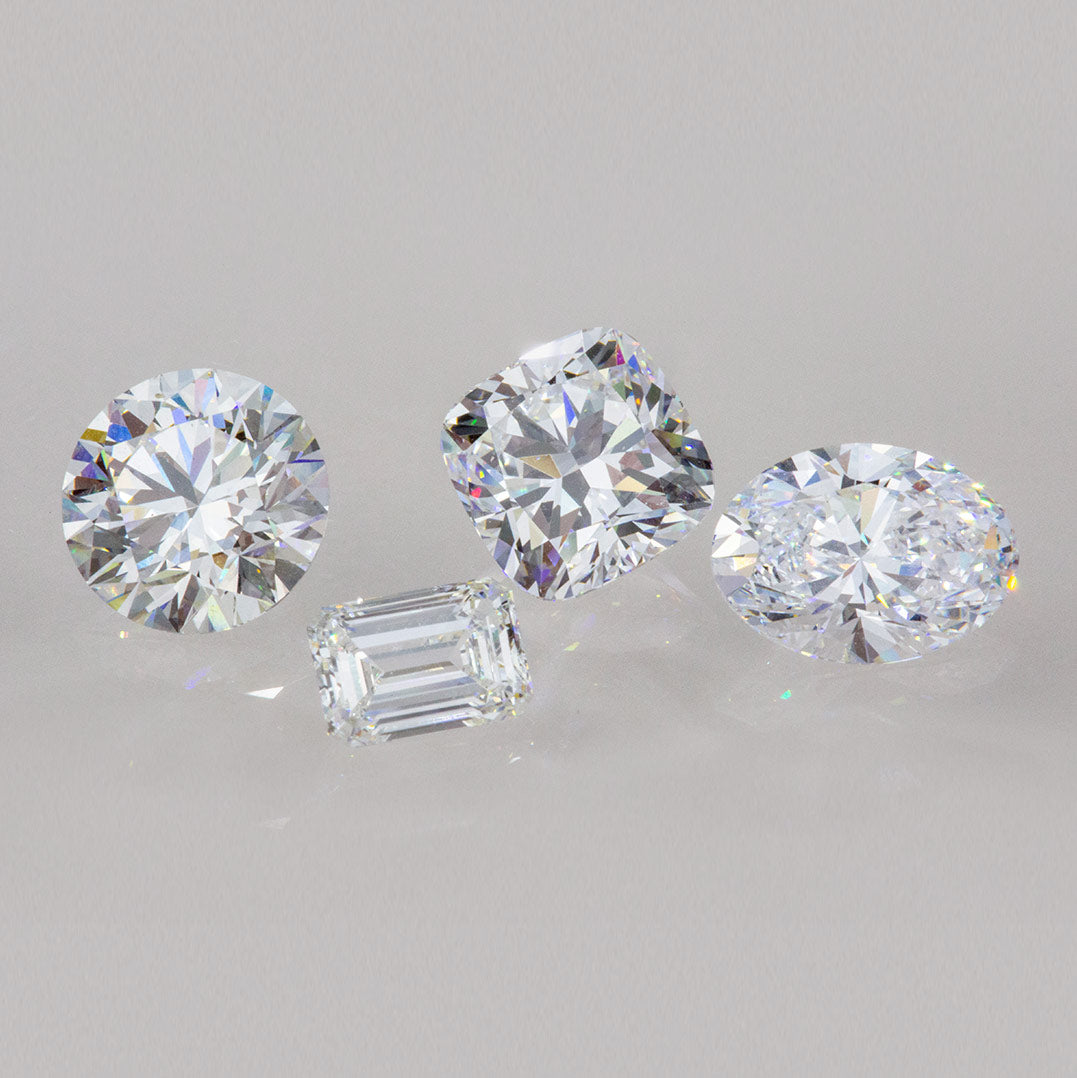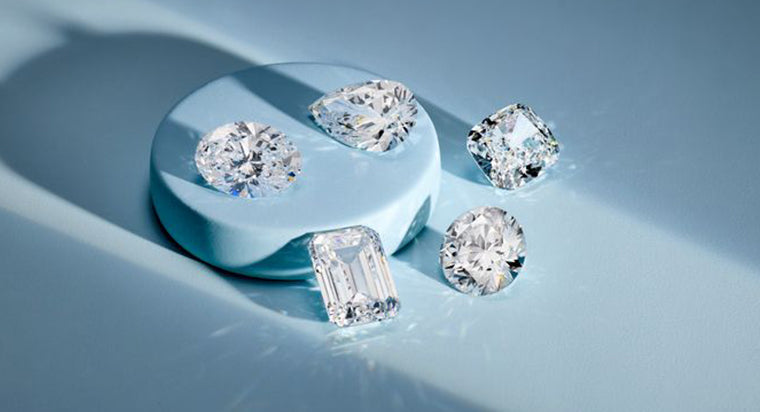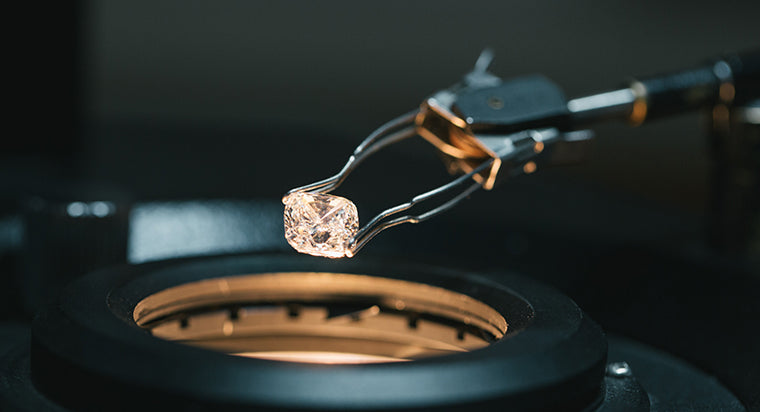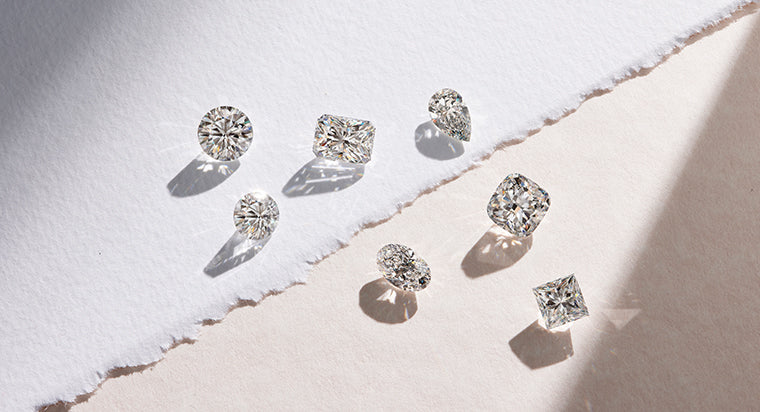Lab Diamonds vs. White Sapphires

If you clicked on this article it’s a safe bet you’re looking for a cost-effective alternative to natural mined diamond jewelry. Whether you are looking to invest in the once-in-a-lifetime purchase of an engagement ring or seeking a budget-friendly alternative to a mined diamond tennis bracelet, it’s never a bad idea to learn about the jewelry alternatives that lab diamonds and white sapphires offer.
TABLE OF CONTENTS
Lab-Created Diamonds

What are they?
Lab-created diamonds are simply stated diamonds that are created in the laboratory through the use of science. Rather than enduring eons of heat and pressure far beneath the earth’s mantel, a synthetic or lab-created diamond can grow over the course of a few weeks.
How are they made?
For centuries, a natural diamond was one of the most sought-after gemstones known to man. Luckily, science has allowed man to harvest the beauty of a natural-minded diamond without requiring the generations of waiting that the natural creation of a diamond requires. Although there is more than one way to make a lab diamond, the Chemical Vapor Deposition (CVD) method, is the preferred method. In the CVD method, a mixture of hydrocarbon is formed into a plasma. this plasma of methane gas and hydrogen is pumped into a growth chamber containing a disc that has been populated with between 15 and 30 diamond seeds. This disc is placed within a microwave reactor where temperatures are increased to between 900 and 1200 degrees. This causes the creation of a super hot plasma ball. The diamond seeds become coted with the superheated plasma and carbon atoms adhere to the diamond seeds one atom at a time. Over the course of three to four weeks, this process is repeated creating a crystal structure identical to that of a natural diamond. Once this process is completed, a jeweler will cut and polish the created gemstone just as they would a naturally occurring diamond.
The other option for creating a diamond in the lab is the High-Pressure High-Temperature method (HPHT). This method uses a belt press to mimic the conditions that produce a diamond deep underground. Pressures exerted in the HPHT method begin at about 50,000 atm. {ressire os exerted upon a cylindrical capsule with a carbon source at the top, a metal slug in the middle, and a diamond seed at the bottom. Temperatures in excess of 12,000 degrees Celsius are applied by introducing an electric current. Once the temperature and pressure levels reach the right level, the carbon begins to form a diamond.
White Sapphires
Most gem buffs will think of an intensely blue gemstone when you mention sapphires. However, sapphires are available in a range of colors. For example, a ruby is in fact the red version of the corundum mineral that produces sapphires. If you are looking for a colorless alternative to a natural mined diamond, white sapphire is one such option.
What are they?
Sapphires are derived from the corundum mineral and require millions of years to form. Naturally occurring white sapphires are rare. However, you will frequently find lab-created white sapphires in jewelry.
How are they created?
Sapphires were some of the first gems to be created in a lab. Sapphires are synthesized by either melting or by hydrothermal synthesis. The process of creating a sapphire by melting is referred to as flame fusion. Aluminum oxide, the main mineral in corundum, is heated with a flame and melted. Once melted, a teardrop shape, called a boule, is formed. Minerals are added to the aluminum oxide if the intention is to produce a colored sapphire.
The other process for creating a lab-created white sapphire is hydrothermal synthesis. This process mimics the natural process of sapphire creation. Here, a tiny natural sapphire seed crystal is placed into a champer. Intense levels of pressure and high temperatures are introduced into the changer, and sapphire crystals form.
Comparing Lab Diamonds and Sapphires
As we discussed above, there are two processes available to create both lab diamonds and created white sapphires in a laboratory. While a lab diamond is created from carbon, a lab-created white sapphire begins with the mineral corundum. So, while a lab diamond is a diamond, a white sapphire, whether natural or lab-created, is not.
- Appearance: To most people, a white sapphire will look the same as a lab-created, or for that fact a natural, diamond. Both gemstones are colorless and emit remarkable sparkle and shine. However, because of the way light is refracted, a white sapphire will have a duller appearance than a diamond.
- Durability: Diamonds are much stronger than sapphire. While a lab diamond is as hard as a natural diamond, which is the hardest mineral we have identified, sapphire is not. For example, a diamond is rated 10 on Moh’s scale of hardness. A sapphire, however, rates a 9 and is considered the third hardest known mineral. So although a sapphire is very hard, it is more likely to show wear than a diamond.
- Grading: Sapphires and diamonds are rated using a different scale for clarity. Lab diamonds, however, are rated exactly the same way natural diamonds are. Sapphires have a wider range of inclusions than diamonds do. There is no such thing as a flawless rating for a sapphire.
- Value: A lab-created white sapphire is considerably less expensive than a natural diamond. However, you should also consider that a lab diamond is also less valuable than a natural diamond of similar quality and size.
- Popularity: Both lab diamonds and white sapphires have gained popularity over the years due to the fact that they are more affordable than mined diamonds. Also, some people consider created stones a more ethical option to mined diamonds.
While both lab diamonds and white sapphires offer beauty and affordability, some people will prefer a lab diamond because of its improved durability and sparkle. Which option is best for you will depend upon the reason you are looking at these alternatives. Despite some loss in sparkle, you may prefer a white sapphire if it means you can afford a larger stone than you might otherwise be able to
FAQs
Is white sapphire harder than lab diamond?
No, A diamond, lab-created or natural, is significantly harder than a white sapphire. A diamond is considered the hardest mineral we have identified. White sapphires are considered one of the third-hardest identified minerals.
Does lab diamond sparkler more than white sapphire?
Yes. Lab diamonds sparkle just like a natural mined diamond. However, a white sapphire refracts light differently than diamonds do. This means that a white sapphire will look duller than the diamond does.
Which is more durable, lab diamond or white sapphire?
The durability of a lab diamond is exactly like that of a natural diamond. A white sapphire however it may look like a diamond isn’t a diamond. The white sapphire rates a 9 on the Moh’s Scale of Hardness while a diamond rates a 10.
Are lab diamonds real?
Yes, lab diamonds are “real” diamonds. The difference between a lab diamond and a mined diamond is in how they are created.









